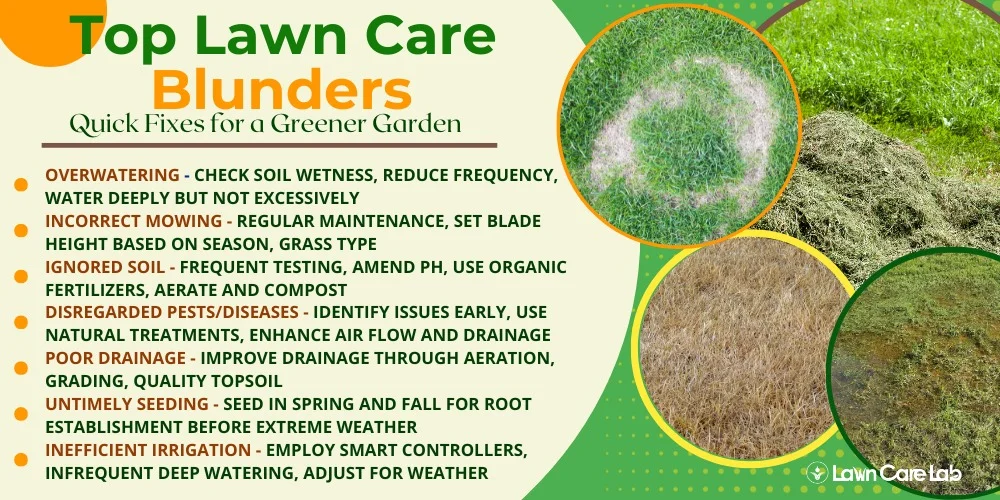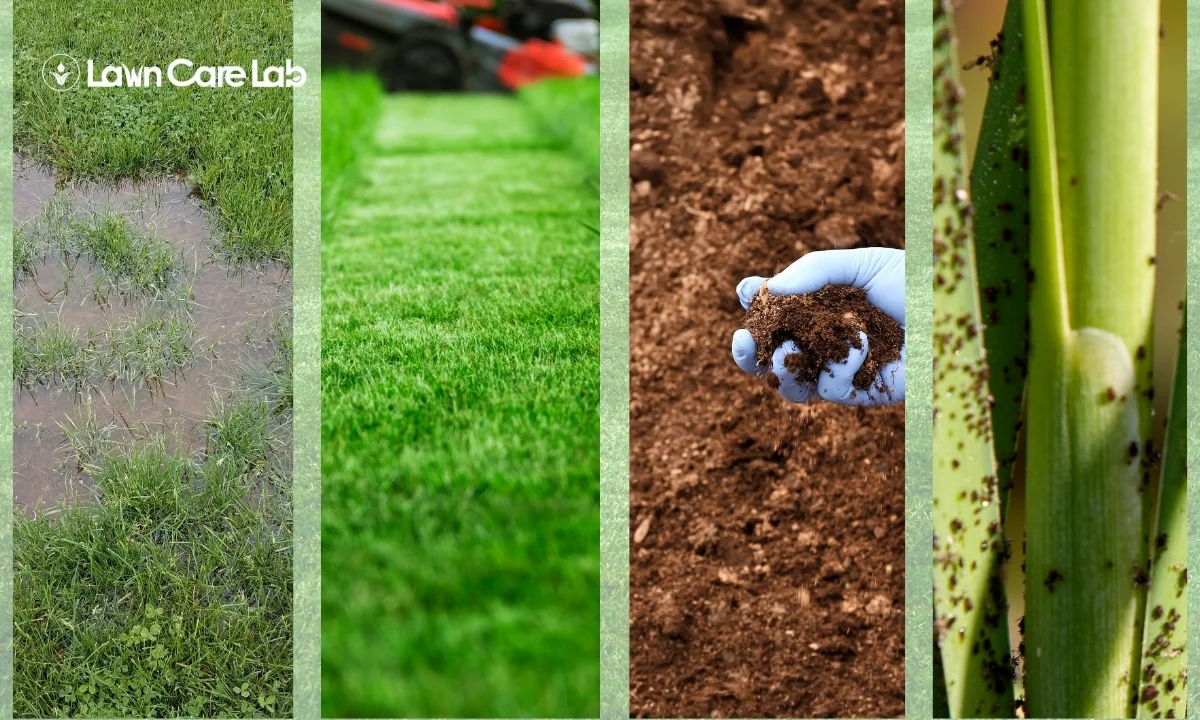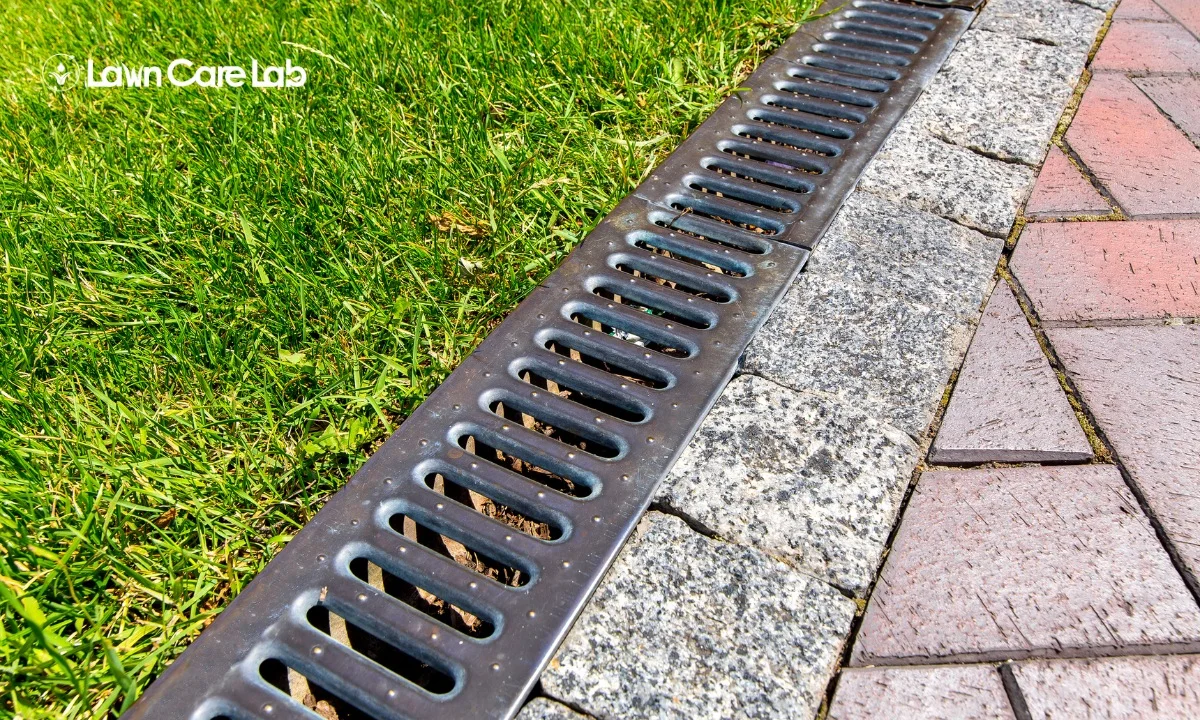No need to envy your neighbor’s green grass; you can cultivate an even lusher one yourself! But watch out for common lawn care blunders like overwatering, improper mowing, or neglecting soil health and garden pests.
Don’t worry, though, we’re here to guide you around these mistakes to get your lawn in top-notch condition.

Ready to transform your yard into the greenest spot in the neighborhood? Let’s get started!
Table of Contents
Overwatering: The Silent Grass Killer
Did you know that excessive watering can actually harm your grass? If you’re not mindful, it’s possible to drown your lawn without realizing it.
Overwatering can choke the roots of your grass, transforming your beautiful green space into a muddy disaster. But there’s no need to stress.
A simple adjustment to your watering routine can quickly rectify the situation, helping you maintain a vibrant and healthy lawn.
Signs you’re giving too much water
You could be overwatering if you spot yellow spots and constant puddles on your lawn.
Soggy soil that stays wet for long after watering is a sure sign of distress.
Changing your watering habits can avoid such problems and promote a more vibrant, lush lawn.
Yellow patches on the lawn
You might give it too much water if your lawn is sporting yellow patches. The grass is quietly telling you it’s over-hydrated. Don’t worry, we’ve some creative fixes for you.
First, give your lawn a makeover and return its lush green look.
Next, protect it from further harm by keeping fungus at bay.
Lastly, make sure there’s proper drainage to tackle any nutrient deficit.
Using these strategies can help maintain the health of your lawn.
But what about that annoying problem of waterlogged soil and standing water? Let’s get into it.
Soggy ground and puddles
Yellow patches in your garden are caused by excess watering. Spotting the signs can be tricky, but managing it is possible. Try new drainage techniques, collect rainwater, or consider wetland gardening, permeable surfaces, or raised beds.
These can help dodge the issue of waterlogged soil, leading you toward a healthier and more vibrant garden.
Optimal watering practices for a healthy lawn
Watering your lawn properly is crucial for maintaining its lush green appearance. Knowing the right watering schedule, amount, and tools for your soil type is key to preventing overwatering and damaging your grass.
Here’s a quick rundown:
Water your lawn early in the morning. It’s the best time since it minimizes water loss due to evaporation and lets the grass dry before the evening, reducing the chances of disease.
Your goal should be to get the water about 6 inches deep into the soil. It promotes root growth and helps your lawn withstand dry spells.
Lastly, consider using tools like sprinklers for even water distribution and techniques like aeration for those hard-to-reach compacted areas.
Mowing Mistakes: Cutting Too Short or Too Long
It’s often overlooked, but how you mow can greatly impact the well-being of your lawn.
Trimming the grass too short can cause stress and encourage weed growth.
Conversely, letting it grow excessively long can lead to disease and an unkempt look.
The ideal grass height for different seasons
Unknowingly, your lawn might suffer if you cut the grass too short or leave it too long. It’s crucial to tweak your mowing height depending on the season to keep your lawn thriving.
During summer, strive for a grass blade length of 3-4 inches to safeguard the roots. Similarly, let your grass grow to the same length in the winter to provide insulation.
Summer lawn mowing tips
When tending to your lawn this summer, avoid the usual pitfall of trimming your grass excessively short or allowing it to grow too lengthy, as the optimal height fluctuates with the change of seasons.
This misstep can negatively impact the soil’s health and the efficacy of watering during the hot months.
Aim to maintain your grass height around 3-4 inches to shield it from the heat.
Avoid mowing it too short, as it may cause the soil to dry out quickly.
Conversely, a slightly taller grass helps retain moisture better.
Winter lawn maintenance
Even when it’s cold outside, keeping your lawn trimmed at the right height is essential. Avoid cutting it too short or letting it get too lengthy.
Remember to water your lawn and keep your mower in good condition during winter. It’s also a good idea to fertilize your lawn.
The risks of mowing your grass too short
Mowing your lawn too short can be harmful to your grass. Scalping can lead to sparse grass, increased weed growth, and drought stress due to faster soil moisture loss.
Maintaining a healthy lawn requires knowing the right grass height. Leaving a little extra length when mowing can contribute to a greener lawn.
Ignoring Soil Health: The Foundation of a Lush Lawn
It’s easy to forget that the health of your grass is deeply connected to the quality of the soil underneath.
Identifying typical soil problems is the initial move towards a more verdant, lush lawn.
Spending time to understand and use organic fertilizers and compost can significantly enhance the fertility and composition of your soil.
Common soil issues and how to spot them
Don’t neglect the state of your garden’s soil – it’s the backbone of a thriving lawn. Common problems like soil compaction and pH imbalances can be tricky.
Compacted soil and aeration
A healthy lawn starts from the ground up. Poor drainage and grass thinning could be due to compacted soil and lack of aeration. To keep your garden flourishing, improve aeration and prevent soil compaction. Understand the benefits and frequency of aeration for optimal results.
Soil pH imbalance and its solutions
Check your soil’s pH level regularly, as it can affect your lawn’s health. Use sulfur or lime to balance the pH level and enhance nutrient uptake.
Consider various soil enhancement solutions to keep your lawn in top shape.
The benefits of organic fertilizers and compost
Organic fertilizers like compost, manure, and alfalfa can revitalize your lawn by feeding soil microbes and fortifying plants. They enhance soil vitality and naturally maintain plant health without harsh chemicals.
Let’s differentiate the types and their usage:
- Compost: It betters drainage and helps retain moisture. Just spread it over the soil.
- Manure: It’s a source of crucial nutrients. Mix it in the soil while planting.
- Alfalfa: It encourages healthy growth. It can be used as a mulch or a compost element.
Trust me, don’t underestimate organic fertilizers. Your lawn will show its gratitude.
Overlooking Pests and Diseases
Prevent lawn damage by identifying and addressing common pests and diseases. Take necessary preventive measures to keep your lawn healthy.
Identifying common lawn pests
Ever noticed those unsightly brown spots or gnawed grass blades on your lawn? They’re not just random occurrences but signs of common yard nuisances like grubs or chinchbugs.
If you disregard these red flags, you might end up with bigger problems like a dying lawn or debris-filled tunnels.
It’s vital to spot these pests early on – it could be the key to maintaining a lush, healthy garden instead of a failing one.
Grubs and their damaged signs
Detecting grub infestation early is crucial to prevent lawn damage. Use beneficial nematodes or milky spores in early summer, routinely check your lawn’s health, and opt for eco-friendly grub control techniques.
Natural solutions for pest control
Combat lawn pests with natural methods like neem or essential oils to avoid using harmful chemicals.
Plant natural pest deterrents to attract helpful bugs and keep pests in check. A diverse garden is both visually appealing and effective against pests.
Prevention strategies for common lawn diseases
Be proactive in preventing and controlling lawn diseases. Spot signs of disease early and use the right treatment to keep your garden healthy.
Here are some essential steps to keep your garden vibrant and healthy:
- Enhancing air circulation and drainage can considerably lessen the chance of fungal diseases.
- Refrain from overfertilizing and watering in the evening, as these can worsen disease progression.
- Keep your mowing height ideal and quickly trim any diseased areas to avoid spreading.
Stay alert, embrace these preventive methods, and your lawn will be grateful.
Conclusion
Wrapping things up, your meticulous care and knowledgeable actions can turn usual gardening mistakes into a flourishing green paradise. Lawn upkeep’s significance extends beyond its visual appeal, contributing to a sustainable ecosystem that enhances your house’s attractiveness.
Let’s quickly revisit the lawn care advice we discussed:
| Mistake | Solution |
| Overwatering | Check the soil’s wetness, water deeply but not too often. |
| Bad Mowing | Regular upkeep, set the correct blade height. |
| Ignored Soil | Frequent soil tests, right fertilization. |
| Pest Problems | Check the soil’s wetness; water deeply but not too often. |
Bear in mind that every lawn has its distinct requirements. Being innovative in your methods can help you steer clear of usual issues and nurture a dense, green lawn.
- Special Considerations and Techniques for Maintaining Sloped Lawns - July 15, 2024
- How Green Spaces Influence Community Interactions - July 8, 2024
- Lawn Fungal Diseases: Identification and Treatment - July 3, 2024




